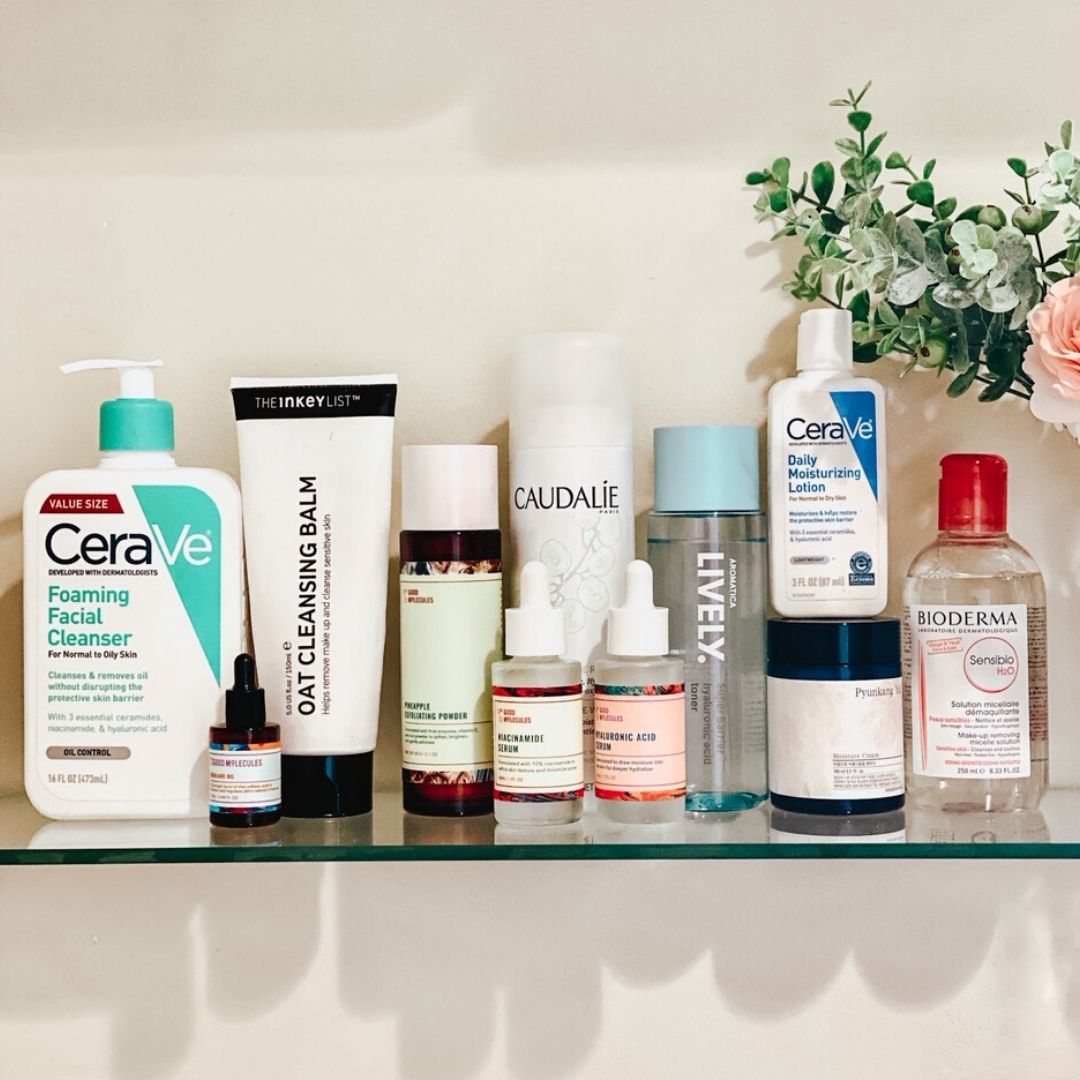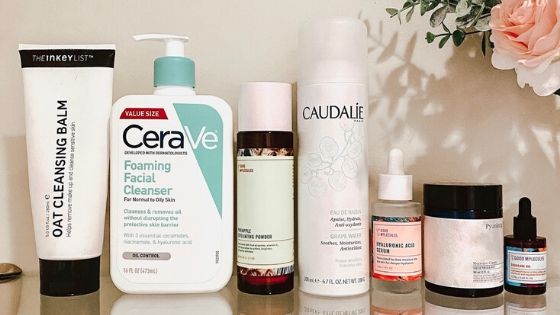As someone always interested in the latest skincare products, I know how easy it is to blow your beauty budget, especially if you’re ingredient-conscious like me.
I’ve been incredibly lucky to receive products due to blogging. But, that doesn’t mean I want to break the bank all the time. Luckily, there are tons of affordable options that can rival their more expensive and popular counterparts. There are actually a few products that even the most experienced skincare guru would struggle to differentiate between once they applied it to their skin.
So, let’s create a budget-friendly skincare routine! In light of our current environment, I think it’s timely. Plus, it’s always good to know that we can all have a good routine without breaking the bank!
To see my budget-friendly skincare routine, keep reading! And if you’re just starting your skincare journey, check out my post on How To Build A Skincare Routine, so you know what products you’ll need first.
Everyone can have a good skincare routine without breaking the bank!
Tweet
My Morning Skincare Routine
Step 1: Cleanser
I always look for a gentle, non-drying cleanser, especially since I have sensitive skin. A few economical options I like are:
- COSRX Low pH Good Morning Gel Cleanser ($10)
- Hada Labo Gokujyun Hyaluronic Acid Face Foam ($11)
- Cerave Hydrating Face Cleanser ($14)
These cleansers are free of harsh sulfates so they won’t strip or irritate your skin. And each of these is under $15!
If you prefer something milder, you can use a micellar water like Bioderma Sensibio H2O ($15) on a cotton pad. As I’ve stated before, I don’t use micellar water every day, and I wouldn’t recommend anyone to use it in replacement of a real face wash.
Step 2: Vitamin C Serum
This step is technically “optional” in a basic skincare routine. But, I believe everyone can use an antioxidant, and I am a big fan of vitamin C serums. I, personally, use a vitamin C serum almost every day.
Mad Hippie Vitamin C Serum ($27) is a great budget-friendly vitamin C serum because it’s lightweight, non-oily, and super stable. It contains sodium ascorbyl phosphate, which is a vitamin C derivative that treats hyperpigmentation and dullness.
Of course, serums with the active form of vitamin C, l-ascorbic acid, are even more potent. But, they aren’t as stable and oxidize quickly. I really enjoy Paula’s Choice C15 Super Booster ($49), and that bottle lasts me about three months.
Step 3: Hydrating Mist
If you’re not familiar with them, face mists are liquids that you mist on your skin using a spray bottle or atomizer. I, personally, love ones that are packed with hydrating and soothing ingredients. Caudalie Grape Water ($10) is one of my favorites and has been in my arsenal for years.
Step 4: Hyaluronic Acid Serum
I’ve thoroughly enjoyed higher-end hyaluronic serums like Pestle and Mortar Hyaluronic Serum, Drunk Elephant B-Hydra Hydrating Serum, NIOD Multi-Molecular Hyaluronic Complex, and Dr. Barbara Hyaluronic Sturm. Just check my blog and social media channels. But, there are good, less-expensive hyaluronic serum options.
- L’oreal Revitalift Pure Hyaluronic Acid Serum ($21)
- The Inkey List Hyaluronic Acid ($15)
- Good Molecules Hyaluronic Acid Serum ($6)
- The Ordinary Marine Hyaluronics ($15)
These are all worthwhile options, AND they’re all under $25.
Step 5: Moisturizer
Let me start by saying that you don’t need to spend a ton of money on a good moisturizer. Cheaper moisturizers will perform just as well.
During the spring and summer months, I like a lighter moisturizer. And during the fall and winter months, I tend to reach for richer formulas. Right now, I’m enjoying Paula’s Choice Water-Infusing Electrolyte Moisturizer ($35), Drunk Elephant’s Protini Polypeptide Cream ($68) and Good Science Beauty Hydrating Cream ($98). A few economical alternatives are:
- Pyunkang Yul Moisture Cream ($25) – This formula has a unique sleeping mask texture to seal in hydration.
- The Ordinary Natural Moisturizing Factors + HA ($17) – While this formula doesn’t feel or smell as decadent as some of my more expensive moisturizers, it’s 3x cheaper and provides a serious moisture barrier on your skin.
- MUJI Moisturizing Milk/Lotion ($15) – Although this is a lightweight formula, I love how moisturizing this is. Gothamista recommended this a while back, and, of course, it contains no common skin irritants.
Step 6: Sunscreen
Sunscreen is your most crucial skincare product and needs to be worn every day, year-round. I have two go-to sunscreens, and that’s the Paula’s Choice Youth Extending Daily Hydrating Fluid SPF50 ($33) and the Supergoop Unseen Sunscreen ($34). For more affordable alternatives, I would look into:
Both don’t leave me looking casket-ready, and they’re both fragrance-free and water-resistant.
My Evening Skincare Routine
Step 1: Oil Cleanser
I’ve talked about double cleansing ad nauseam. If you wore any makeup, sunscreen, or any silicone-based products, you need to double cleanse. The only time I don’t double cleanse is if I haven’t applied SPF or makeup.
As far as oil cleansers go, here are a few budget-friendly options:
- Clinique Mini Take The Day Off Cleansing Balm ($10)
- The Inkey List Oat Cleansing Balm ($10)
- DHC Deep Cleansing Oil ($21)
These are some of my go-to cleansing oils. These no-frill formulas are great at removing everything, even the most stubborn eye makeup.
Step 2: Water-Based/Cream Cleanser
Next, we apply a water-based cleanser to remove impurities like sweat and dirt. Here is where you can use the cleanser you used in your morning routine.
Step 3: Exfoliator
If you’ve been following me, you know that I’m a big fan of chemical exfoliants. Exfoliating acids do the work for me, so I don’t have to rub and tug at my skin manually. My favorite chemical exfoliants are Paula’s Choice Skin Perfecting 2% BHA Liquid Exfoliant, Biologique Recherche’s P50V 1970, Drunk Elephant’s T.L.C. Framboos Glycolic Resurfacing Night Serum, and Dr. Barbara Sturm’s Enzyme Cleanser. A few economical alternatives are:
- Good Molecules Pineapple Exfoliating Powder ($16) – This can be considered a dupe for Dr. Barbara Sturm’s Enzyme Cleanser. It’s not as elegant of a formulation, but it’s effective.
- Tarte Knockout Mini Tingle Treatment Toner ($18) – Although I don’t believe this is a dupe for the P50V 1970 as other people have claimed, I can say that it does exfoliate, refine the look of pores, and balance and brighten the skin.
- First Aid Beauty Facial Radiance Pads ($17) – These pads remove dead skin cells with two AHAs (lactic acid and glycolic acid). They’re also gentle enough for most skin types since the formula is alcohol-free and high in aloe vera and glycerin.
Step 4: Hydrating Mist
Here’s where you can use the hydrating mist you used in your morning routine.
Step 5: Hyaluronic Acid Serum
Here’s where you can use the hyaluronic acid serum you used in your morning routine.
Step 6: Moisturizer
Here’s where you can use the moisturizer you used in your morning routine.
Step 7: Face Oil
A layer of face oil locks in all the goodness you applied beforehand and helps prevent overnight moisture loss. I have a wide range of face oils, but I have some excellent budget-friendly options too.
I love rosehip oil because it’s packed with beauty essentials like anti-inflammatory fatty acids and vitamins A and C. These ingredients treat signs of aging and hyperpigmentation, hydrate and repair damaged skin, and provide a substantial protective antioxidant boost. I’m currently using Pai Skincare Rosehip BioRegenerate Oil ($40), but some cheaper alternatives are:
- Trilogy’s Certified Organic Rosehip Oil ($19)
- Good Molecules Rosehip Oil ($10)
- Acure The Essentials Rosehip Oil ($13)
- The Ordinary 100% Organic Cold-Pressed Rosehip Oil ($19)
- The Inkey List Rosehip Oil ($23)
Squalane oil is known for its anti-aging benefits. It helps balances oil production and has powerful anti-inflammatory benefits to help with skin conditions like acne and eczema. I’ve been using Indie Lee Squalane Facial Oil ($34) and Good Molecules Squalane Oil ($6), but some other alternatives are:
- Acure The Essentials 100% Plant Squalane Oil ($20)
- The Ordinary 100% Plant-derived Squalane Oil ($16)
- The Inkey List Squalane Oil ($12)
Marula oil is an antioxidant-rich oil, packed with essential fatty acids, vitamin C, vitamin E, and flavonoids that deeply moisturize skin, repair skin cells, and leave the skin looking vibrant. I’ve been using Drunk Elephant Virgin Marula Oil for a few years now, but some other alternatives are:
- Acure The Essentials Marula Oil ($12)
- Naturium Virgin Marula Face Oil 100% ($16)
- The Ordinary 100% Cold-Pressed Virgin Marula Oil ($11)
Optional Skincare Extras
Since this is a budget-friendly routine, I didn’t include these products as a part of the core routine. But, you can definitely add them, depending on your needs and preferences.
- EYE CREAM: If you prefer a separate eye cream instead of just using your regular moisturizer, some affordable options are The Inkey List Brighten-i Eye Cream ($10), Hada Labo Tokyo Age Correcting Eye Cream ($14), and Derma E Hydrating Eye Cream ($15).
- ADDITIONAL TREATMENT SERUMS: As you all know, I’m a layering queen! And you can find effective and affordable serums from brands like Good Molecules, The Ordinary, and The Inkey List. There are inexpensive essences too. Check out some of my favorite essences and serums here.
- LIP BALM: Bioderma Atoderm Lèvres Restorative Lip Balm and Aquaphor Lip Repair heal chapped lips like nothing else.
- CLEAN TOWELS: I use the Clean Skin Club Clean Towels in my morning and evening routines. They are durable, biodegradable, and soft on the skin. They’re $15 a box, and you can get 20% off when order using my promo code BEAUTYINCOLOR. They’re also sold on Amazon but you cant take advantage of the 20% discount on Amazon.
Are you ready to create your budget-friendly skincare routine? If so, products would you use? Have you tried any of the products in this post?




